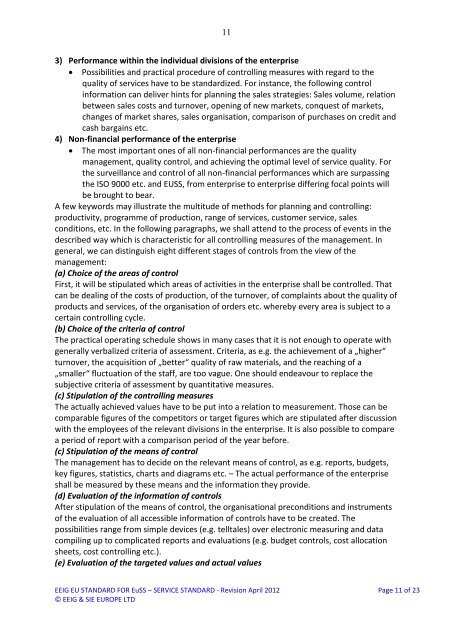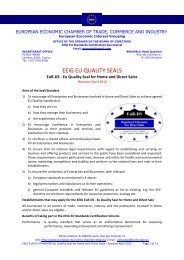eeig eu standards - EUROPEAN ECONOMIC CHAMBER of Trade ...
eeig eu standards - EUROPEAN ECONOMIC CHAMBER of Trade ...
eeig eu standards - EUROPEAN ECONOMIC CHAMBER of Trade ...
You also want an ePaper? Increase the reach of your titles
YUMPU automatically turns print PDFs into web optimized ePapers that Google loves.
11<br />
3) Performance within the individual divisions <strong>of</strong> the enterprise<br />
Possibilities and practical procedure <strong>of</strong> controlling measures with regard to the<br />
quality <strong>of</strong> services have to be standardized. For instance, the following control<br />
information can deliver hints for planning the sales strategies: Sales volume, relation<br />
between sales costs and turnover, opening <strong>of</strong> new markets, conquest <strong>of</strong> markets,<br />
changes <strong>of</strong> market shares, sales organisation, comparison <strong>of</strong> purchases on credit and<br />
cash bargains etc.<br />
4) Non-financial performance <strong>of</strong> the enterprise<br />
The most important ones <strong>of</strong> all non-financial performances are the quality<br />
management, quality control, and achieving the optimal level <strong>of</strong> service quality. For<br />
the surveillance and control <strong>of</strong> all non-financial performances which are surpassing<br />
the ISO 9000 etc. and EUSS, from enterprise to enterprise differing focal points will<br />
be brought to bear.<br />
A few keywords may illustrate the multitude <strong>of</strong> methods for planning and controlling:<br />
productivity, programme <strong>of</strong> production, range <strong>of</strong> services, customer service, sales<br />
conditions, etc. In the following paragraphs, we shall attend to the process <strong>of</strong> events in the<br />
described way which is characteristic for all controlling measures <strong>of</strong> the management. In<br />
general, we can distinguish eight different stages <strong>of</strong> controls from the view <strong>of</strong> the<br />
management:<br />
(a) Choice <strong>of</strong> the areas <strong>of</strong> control<br />
First, it will be stipulated which areas <strong>of</strong> activities in the enterprise shall be controlled. That<br />
can be dealing <strong>of</strong> the costs <strong>of</strong> production, <strong>of</strong> the turnover, <strong>of</strong> complaints about the quality <strong>of</strong><br />
products and services, <strong>of</strong> the organisation <strong>of</strong> orders etc. whereby every area is subject to a<br />
certain controlling cycle.<br />
(b) Choice <strong>of</strong> the criteria <strong>of</strong> control<br />
The practical operating schedule shows in many cases that it is not enough to operate with<br />
generally verbalized criteria <strong>of</strong> assessment. Criteria, as e.g. the achievement <strong>of</strong> a „higher“<br />
turnover, the acquisition <strong>of</strong> „better“ quality <strong>of</strong> raw materials, and the reaching <strong>of</strong> a<br />
„smaller“ fluctuation <strong>of</strong> the staff, are too vague. One should endeavour to replace the<br />
subjective criteria <strong>of</strong> assessment by quantitative measures.<br />
(c) Stipulation <strong>of</strong> the controlling measures<br />
The actually achieved values have to be put into a relation to measurement. Those can be<br />
comparable figures <strong>of</strong> the competitors or target figures which are stipulated after discussion<br />
with the employees <strong>of</strong> the relevant divisions in the enterprise. It is also possible to compare<br />
a period <strong>of</strong> report with a comparison period <strong>of</strong> the year before.<br />
(c) Stipulation <strong>of</strong> the means <strong>of</strong> control<br />
The management has to decide on the relevant means <strong>of</strong> control, as e.g. reports, budgets,<br />
key figures, statistics, charts and diagrams etc. – The actual performance <strong>of</strong> the enterprise<br />
shall be measured by these means and the information they provide.<br />
(d) Evaluation <strong>of</strong> the information <strong>of</strong> controls<br />
After stipulation <strong>of</strong> the means <strong>of</strong> control, the organisational preconditions and instruments<br />
<strong>of</strong> the evaluation <strong>of</strong> all accessible information <strong>of</strong> controls have to be created. The<br />
possibilities range from simple devices (e.g. telltales) over electronic measuring and data<br />
compiling up to complicated reports and evaluations (e.g. budget controls, cost allocation<br />
sheets, cost controlling etc.).<br />
(e) Evaluation <strong>of</strong> the targeted values and actual values<br />
EEIG EU STANDARD FOR EuSS – SERVICE STANDARD - Revision April 2012 Page 11 <strong>of</strong> 23<br />
© EEIG & SIE EUROPE LTD





